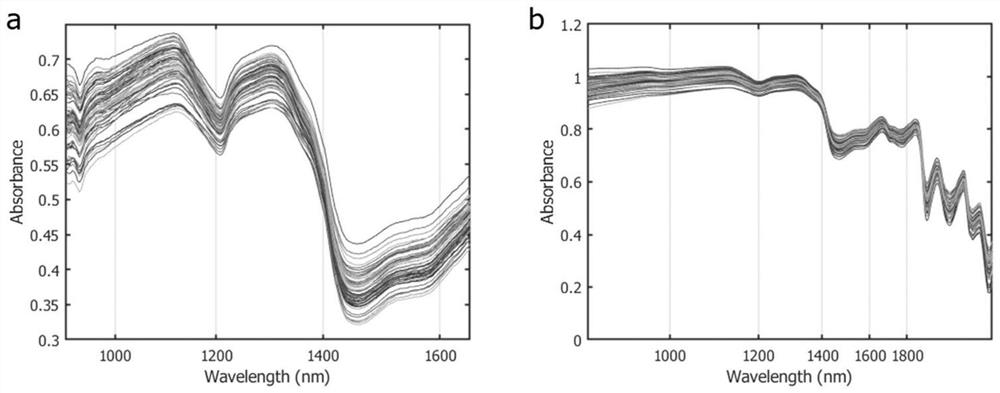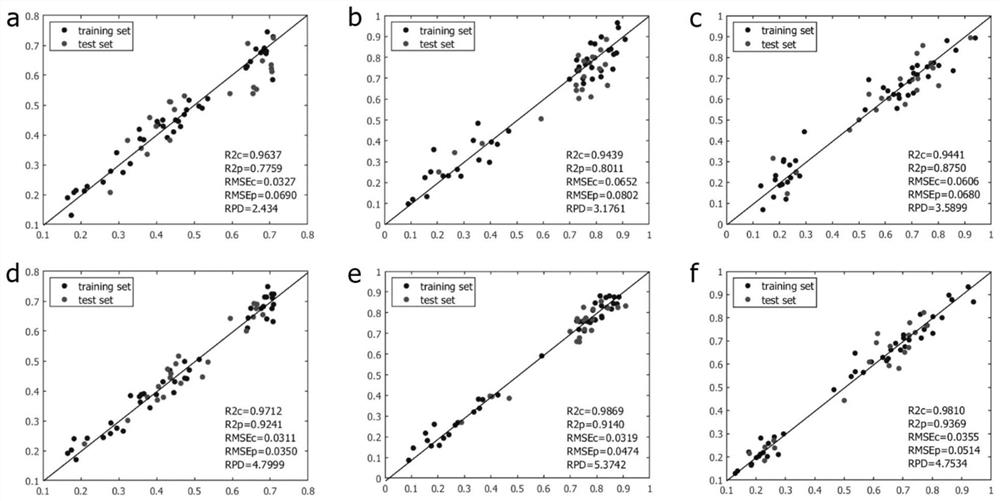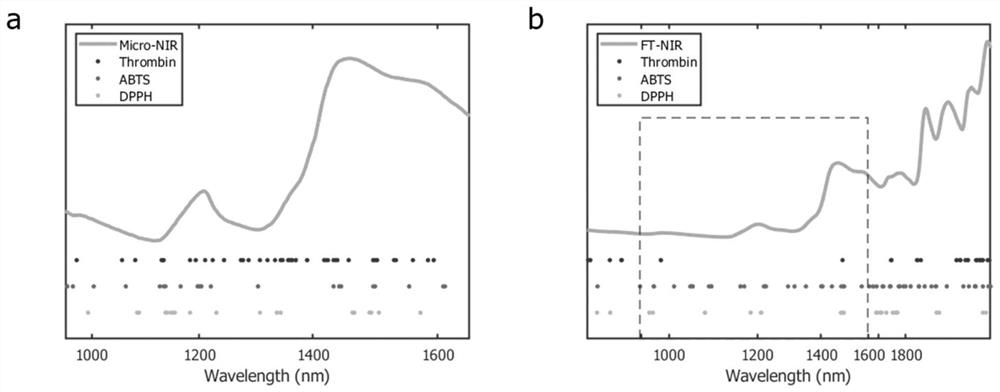Detection model and method for rapidly detecting quality of curcuma zedoary
A detection model and technology of curcuma, which is applied in the field of rapid detection of the quality of curcuma, can solve the problems of low resolution, narrow range, spectral resolution decline, etc., and achieve rapid detection, good accuracy and robustness
- Summary
- Abstract
- Description
- Claims
- Application Information
AI Technical Summary
Problems solved by technology
Method used
Image
Examples
Embodiment 1
[0038] The prediction of embodiment 1 turmeric thrombin inhibitory rate
[0039] The method of establishing the detection model is as follows:
[0040] 1. Test the infrared spectrum curve of the curcuma sample
[0041] 1) Use a portable near-infrared spectrometer (NIR-S-R2: InnoSpectra Company, Taiwan, China) to collect spectral data of raw and vinegar zedoary samples in absorption mode at room temperature. The spectrometer weighs about 80 grams and has a spectral range of 900-1650nm. It can be connected to other devices such as smartphones or tablets via Bluetooth. The manufacturer (China, InnoSpectra Corporation, Taiwan) provides a smartphone app. China) portable near-infrared spectrometer. According to the manufacturer's instructions, the app was downloaded and installed on a smartphone running Android to collect and store spectral data in cvs format. Then, the spectrum files stored on the smartphone are uploaded to the laboratory host through wireless network. The tran...
Embodiment 2
[0062] The prediction of the clearance rate of embodiment 2 Curcuma ABTS
[0063] The method of establishing the detection model is as follows:
[0064] 1. Test the infrared spectrum curve of the curcuma sample
[0065] The method is the same as in Example 1.
[0066] 2. Test the clearance rate of ABTS of Curcuma samples
[0067] The ABTS free radical decolorization experiment belongs to the prior art, and is used to describe the free radical scavenging ability of the sample (the scavenging rate of ABTS). After ABTS (McLean) is dissolved in water to 7mmol / L, take an equal amount of ABTS solution and 140mmol / L K 2 S 2 o 8 The aqueous solution should be filtered with a 0.22um microporous membrane before mixing. The reaction solution was stored at room temperature (25±2° C.) in the dark for 12-16 hours. Since the inhibition rate should be between 20-80%, the samples with the strongest and weakest free radical scavenging ability were firstly explored through preliminary exp...
Embodiment 3
[0082] The prediction of the clearance rate of embodiment 3 curcuma DPPH
[0083] The method of establishing the detection model is as follows:
[0084] 1. Test the infrared spectrum curve of the curcuma sample
[0085] The method is the same as in Example 1.
[0086] 2. Test the scavenging rate of DPPH in the curcuma sample
[0087]The determination of the scavenging rate of DPPH belongs to the prior art. It detects the purple free radical change in the ethanol solution by spectrophotometry. When the sample presents a good free radical scavenging ability, the microplate reader can be measured by the reduction of the color The degree of reduction of the sample to free radicals, thereby obtaining the antioxidant capacity of the sample. In this study, microplates were used for one-off assays to avoid errors caused by multiple assays. The specific plan is to mix 20 μL of zedoary extract and 100 μL of 0.2mmoL / L DPPH solution into a 96-well plate, and use methanol as a control,...
PUM
 Login to View More
Login to View More Abstract
Description
Claims
Application Information
 Login to View More
Login to View More - R&D
- Intellectual Property
- Life Sciences
- Materials
- Tech Scout
- Unparalleled Data Quality
- Higher Quality Content
- 60% Fewer Hallucinations
Browse by: Latest US Patents, China's latest patents, Technical Efficacy Thesaurus, Application Domain, Technology Topic, Popular Technical Reports.
© 2025 PatSnap. All rights reserved.Legal|Privacy policy|Modern Slavery Act Transparency Statement|Sitemap|About US| Contact US: help@patsnap.com



